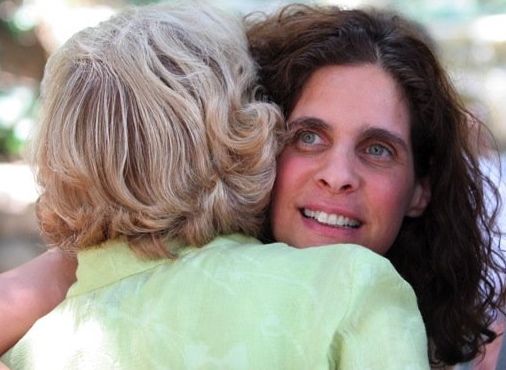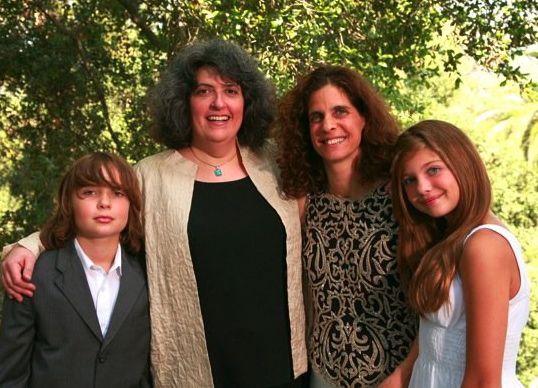Sarah Palin: The Sitcom
On his new blog, Charles Oliver imagines the possibilities.
On his new blog, Charles Oliver imagines the possibilities.
I realize this is a minority view, but I thought it was boring and unmemorable, good mostly because it didn't make any real news. (Bill did his part to elect Barack Obama back in South Carolina.)
Two astute points from Stephen Green:
Clinton very pointedly mentioned crushing "credit card debt." And Biden is pretty much a wholly-owned subsidiary of Delaware's many credit card companies. Clinton knows that. The media know that. And pretty soon they'll remind you of it, too....
Michelle Obama noticed, too. When Michelle really smiles, she lights up the entire Pepsi Center. All she gave Clinton was her tight, closed-mouth smile.
Cross-posted from my new blog, DeepGlamour.net
John McCain isn't the only one trying to puncture Barack Obama's glamour. So is...Barack Obama.
"Barack Obama is lauded as everyman at Democratic convention" is the headline on this LAT story. The exotic background, cool exterior, and ethnic distance that helped create a glamorous aura in the early days (at least among white voters) have become potential liabilities in the general election. A glamorous icon enables audiences to project their hopes onto him--but they can also project their fears.
It's always been Michelle Obama's job to bring her husband's image back down to earth. She overdid it when she called him "stinky and snorey" and complained that he left dirty socks on the floor. That ordinary voters don't want--too much information. Last night's performance, however, was designed to create a more dignified image of Obama-as-regular-guy, mostly by association (the Robinsons as average American family). This was "Celebrities are just like us," going about their business shopping and taking the kids to the park, not "Stars without makeup," looking sloppy.
Touring over the microphone, Michelle was the picture of polished style. She has a model's figure, made for elegant clothes, and obviously appreciates the shopping benefits of a salary in the range her husband Obama plans to sock with extra FICA taxes. People often compare her to Jackie Kennedy. But, she implicitly assured us last night, she won't be spending any summers cruising the Mediterranean with her princess sister on a Greek shipping tycoon's yacht. That kind of glamour today's politics won't tolerate.
Cross-posted from my new blog, DeepGlamour.net
Beyond the ordinary factors that give the Democrats an advantage this year, Barack Obama's glamour poses a huge problem for the McCain campaign. To destroy glamour, you have to change perceptions. You can try sober realism. But that lacks emotional punch. To strike at glamour's emotional core, horror and ridicule work better. Instead of telling the audience to ignore its desires and be rational, they replace desire with dread or derision. What was once inspirational becomes terrible or absurd.
McCain's "The One" attack ad (now in the new Denver convention version above) is clearly an attempt to strip some of the glamour off Obama. That much is indisputable. Pundits are now arguing about whether the ad's imagery is intended as satire (the ridicule strategy) or as a veiled attempt to paint Obama as the Antichrist (the horror strategy). If you're a cool cosmopolitan character, it's hard to object to satire, even when directed at your favorite political figure. Irony is too much a part of your cultural milieu. Hence the appeal of the horror narrative: The ad isn't mocking Obama for messianic excess. It's literally portraying him as not just any old false messiah but the Antichrist.
What's interesting about this dispute is that it can't be resolved simply by looking at the ad. The interpretation is entirely in the audience's mind. The words and imagery that make Obama look ridiculously messianic are the same words and imagery that make him look like he's usurping the real Messiah's role. There's no way an ad meant to spoof him could avoid the charge of playing to fundamentalist fears. Do you find those words and images silly or scary? It depends on your cultural assumptions.
Though I'm not exactly a fan, I find it hard to believe that John McCain, a man whose humor is a major part of his persona and who clearly thinks Obama is a wet-behind-the-ears pretender, intended anything other than satire. The ad seems like obvious mockery. But it's impossible to disprove that someone in the campaign wanted a "dog whistle" to scare fundamentalists. Like glamour, humor is in the audience's mind. And the people who look at the ad and cry, "Antichrist" see only horror in the Republican base, imagining the worst. (Via Megan McArdle.)

I understand why people who don't have any close gay friends or relatives think single-sex marriage is strange and disruptive. But it isn't. It's merely a way of turning de facto relationships into de jure ones. And the relationships that distinguish de jure marriage aren't so much those between spouses but those between the married couple and other people, perhaps most importantly their extended families. As of July 27, this happy woman went from my sister-not-exactly-in-law, her status for the past two decades, to my actual legal sister-in-law. And the woman she's hugging became her legal mother-in-law, instead of the unofficial relative who comes to visit for a month every year, whose medical care she frets over, and whose new living arrangements she researched. (Did I mention that Mindy, who has a Ph.D. in clinical psychology, is now a stay-at-home mom? How traditional can you get? Steve and I are the radical ones.)

Neither, as some conservatives imagine, was the wedding a mockery of marriage or tradition. This was no Black Mass (or the Jewish equivalent). To the contrary, it was a continuation of cherished religious and family traditions. Pam and Mindy even got married under the chuppa I'd made for our own wedding 22 years ago, back when they were just girlfriends. I cross-stitched an applique with their Hebrew names to cover our own. That I mismeasured and allowed just a tiny bit of ours to peek out seems somehow appropriate. (The couple in the center built the structure that holds up the very heavy chuppa; the versatile woman with the drill is also the cantor.)

Growing up with three younger brothers, I always wanted a sister (though, in retrospect, I was better off being the princess). Then I married a guy with three older sisters and, once all our siblings were paired off, wound up with six de jure sisters-in-law and one de facto one. Gay weddings just mean more posing for awkward group photos--nothing radical about that. (One husband couldn't make it.)

My sisters-in-laws' wedding was less transformative than Andrew Sullivan's--Aunt Mindy has always been just that to Pam's nieces and nephews, who take it for granted that Pam and Mindy's two kids are their cousins--but the wedding does allow the extended family to claim without awkwardness or hesitation the vocabulary set aside to recognize the enduring relationships created by marriage. So I like what Andrew writes in the new Atlantic:
Ours was not, we realized, a different institution, after all, and we were not different kinds of people. In the doing of it, it was the same as my sister's wedding and we were the same as my sister and brother-in-law. The strange, bewildering emotions of the moment, the cake and reception, the distracted children and weeping mothers, the morning's butterflies and the night's drunkenness: this was not a gay marriage; it was a marriage.
And our families instantly and for the first time since our early childhood became not just institutions in which we were included, but institutions that we too owned and perpetuated. My sister spoke of her marriage as if it were interchangeable with my own, and my niece and nephew had no qualms in referring to my husband as their new uncle. The embossed invitations and the floral bouquets and the fear of fluffing our vows: in these tiny, bonding gestures of integration, we all came to see an alienating distinction become a unifying difference.
It was a moment that shifted a sense of our own identity within our psyches and even our souls. Once this happens, the law eventually follows. In California this spring, it did.

If you get an email from a Facebook friend telling you that he/she has a video of you, do NOT click on the link. It's a worm. (Fortunately, I was--I think--saved by the Mac.)
Today's LAT features this amazingly unbalanced front-page story on a proposal--driven by California's state budget crisis--to increase premiums on the state's insurance program for poor kids. Sample sentences:
The state estimates that the parents of 19,000 children will end up dropping out of the program by July because of the $2 or $3 monthly increases. A family with three or more children, earning between two and 2 1/2 times the federal poverty level of $24,800 a year, would see the monthly premium rise to $51.
No, I did not omit the "from [current figure greater than zero]" at the end of that sentence. And, of course, it's written so you remember the $24,800, not the $56,800 to $62,000 to which the $51 actually applies. How many readers are going to do that math?
I'm not against providing a medical safety net for poor kids, but I am against blank checks, sloppy reporting, the misleading use of statistics, and unimaginative policy making. As it happens, just a few days ago I read this report from the Public Policy Institute of California on who uses emergency departments in California hospitals. (The big news is that, contrary to widespread belief, neither Latinos nor noncitizens are particularly heavy users.) The survey found that kids under 18 accounted for nearly a quarter of all emergency department visits, with about 40 percent of those visits paid for by Medi-Cal, the state's insurance program for the poor. Here's more:
Children covered by Medi-Cal have nearly 11 percent more avoidable emergency department visits than privately insured children and about 5 percent more than uninsured children. Nearly one-third of all emergency department visits by privately insured children are injury-related [i.e., actual emergencies--vp], considerably higher than for MediCal children--20 percent--and uninsured children--27 percent. Uninsured children, a relatively small group who constitute only 10 percent of children's visits, have much lower proportions of hospital admissions than children covered by Medi-Cal and by private insurance (1% compared to 6% and 4%, respectively).
The reasons so many kids end up in the emergency room aren't hard to understand. Emergency rooms are open 24 hours a day, so parents can go after work, and you don't have to wait for an appointment. That suggests that some serious cost savings might be possible, if only parents had a cheaper alternative.
One such alternative is beginning to develop: retail clinics in places like (gasp of horror!) Wal-Mart. And new research from the University of Michigan C.S. Mott Children's Hospital National Poll on Children's Health suggests these clinics fill exactly the needs that make emergency rooms so appealing for non-emergency visits:
Overall, 7 out of 10 parents who had used retail clinics for their children said they considered taking their children to the doctor's office. But 40% said they could not get an appointment at the doctor's office, and 46% said they wanted to take care of their children's problem more quickly.
The question for policy makers and social-service groups should be, How do you encourage parents to use such less expensive, more appropriate clinics? That might mean making it easier for clinics to open, or stay open after hours. It might mean educating parents about their availability or giving them some kind of incentive to use clinics rather than emergency rooms. It might mean teaching parents more about when kids really need to see a doctor. But it definitely means doing something more creative than complaining about budget cuts.
The intrepid Michael Totten arrived in Tblisi, Georgia, yesterday.
Watching this ad during the Olympics, I've been puzzled and more than a little concerned. Is this how the anti-Prop. 8 campaign is spending my money? We're doomed. The commercial is mildly amusing, a little poignant, and way too subtle for an initiative campaign. After spending 16 years in the 501(c)3 world, I should have figured out what was going on. As the LAT reports, the ad is not part of the anti-initiative campaign. It's being run by a nonprofit that supports the right of gays to marry.
Of course, as the LAT's Dan Morain writes, "Some experts believe that the ad's producer, Let California Ring, is skirting federal tax law, which restricts political campaigning by nonprofit organizations with tax-exempt status." I'm not a lawyer, but I'd say the "experts" are wrong here. The ad doesn't even come close to the line. It doesn't mention the initiative--or, for that matter, same-sex marriage. It is, as I thought, way too subtle for a campaign ad.
UPDATE: Windypundit Mark Draughn emails:
That ad reminds me of the early days of drug advertising on television, when the restrictions were so tight that most ads couldn't mention what the drug actually did (I guess because they'd need a 10-minute disclaimer explaining the side effects). So we would end up watching these mysterious commercials filled with happy looking people who seemed to really enjoy being outdoors and breathing the fresh air, again and again, until we realized, "Oh! It's about allergies."
UPDATE II: I appreciate the traffic from Andrew Sullivan, but his teeny post was misleading. The whole point of the post above is that a) first I thought, "Is that how my donations have been spent?" b) then I read the story in the LAT and realized that the ad was soft sell because it was NOT a campaign ad and hence had nothing to do with the money I've donated to EQCA c) people who think an ad that doesn't mention the initiative or even gay marriage are wrong to say the ad crosses the legal line d) as further proof of c see a.